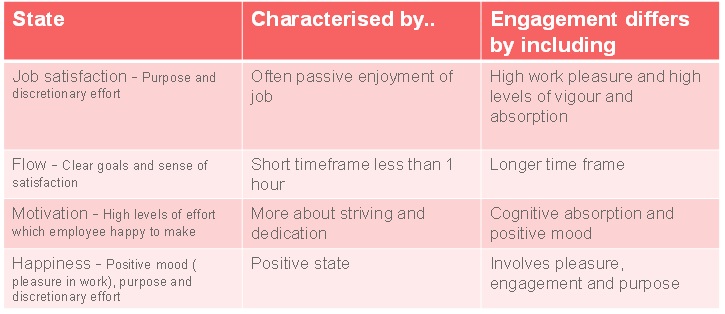An understanding of some aspects of how the brain is ‘wired’ can help you to increase the likelihood of people being engaged at work and avoid creating situations that destroy engagement. There is no set of system in the brain that ensures people are engaged. It’s more complex than that but there are a number of areas that help and this series of articles – The Science of Engagement – will cover the science and the practical implications for creating an environment where people are more engaged.
One issue with engagement is that there is no clear definition. What do I mean by engagement?
Survey companies have created definitions so that they can provide you with benchmark data but this will be dependent on the survey you use. There are often overlaps with other constructs as the table below illustrates.

In a recent breakfast club webinar we asked participants to vote for the descriptions above which most closely matched their definition of engagement (without the labels of what they were). By far the largest number of votes went to ‘happiness.’
It seems that our participants were measuring happiness at work rather than engagement and this illustrates some of the issues with the concept.
The Interplay of Three
We believe employee engagement involves the interplay between three factors: cognitive commitment (purpose), emotional attachment (trust), and the resulting behavioural outcomes (discretionary effort and interest in the results).
There is evidence that drivers of engagement include pride in one’s company and an employee’s relationship with his/her manager. These are well-researched factors which impact engagement and it is these drivers that you can use to improve the engagement of employees.
The Conference Board found that across all the studies reviewed, and for all locations and age groups, there was agreement that the relationship with the immediate line manager is the strongest of all drivers of employee engagement. So focusing on this relationship potentially gives the best return.
Our research would also suggest that having leaders who work in a brain-savvy way results in better business outcomes. Good leaders create engaged employees (or maybe happy employees) who in turn produce business results.
Engagement is not a neurological construct in the brain but a number of aspects do have identifiable brain based processes which differ based on how employees are treated. They are:
- In-group connection
- Purpose
- Positive mood
- Trust
I will describe what science is telling us about creating each of these in future articles in this article series, The Science of Engagement.
For now, let’s take a look at survey scores, or how engagement is measured.
Managing how people rate their engagement
Behavioural economist Daniel Kahneman has shown that we perceive things in two ways: as the “experiencing self” and as the “remembering self.” The experiencing self makes assessments in the moment, but the remembering self creates a coherent story about events in retrospect. The remembering self is a storyteller and creates a story which becomes our memory: this is what we get to keep from our experience.
Kahneman says the remembering self is helping us to make decisions going forward and ultimately determining how satisfied we are with our lives. We don’t choose between experiences, we choose between memories of experiences. Even when we think about the future, we don’t think of our future normally as experiences, we think of our future as anticipated memories.
We don’t think of our future normally as experiences, we think of our future as anticipated memories.
The experiencing and remembering selves act as two different entities, says Kahneman, and this can cause confusion. The remembering self keeps score, maintains the structure of our life and is the one that makes decisions based on the memory we create from an experience.
The importance of endings
If something bad happens at the end of an event it ruins the memory of the experience.
So, for example, say we are engaged in a highly successful project, to design and launch a new HR process: the team works well together, the rollout goes brilliantly but the final debrief ends with the CEO noticing a couple of small things that could have gone better.
The memory of the whole project will be tainted by those last few criticisms. For the remembering self the comments are integrated into the whole memory of the project.
Kahneman says the ending is a critical part of every event. An experiment asked people undergoing a medical procedure to report on their pain every 60 seconds. Those patients who experienced more pain at the end of the operation later reported worse overall pain than they had in fact reported during the procedure.
We can use this insight to great effect in our working lives by ensuring that any bad news is delivered at the beginning of a presentation, and ensure positive memories by making sure good things happen at the end of an event.
Deliver bad nes at the beginning of meetings and presentations and ensure positive memories by making sure good things happen at the end.
The impact on surveys
Based on Kahneman hypothesis a sense of engagement can be very different depending on whether we are recording an experience or remembering the experience – how they think about the experience when they think back on it.
This has important implications for HR policies on engagement. Your survey is almost certainly collecting data on the memory not the experience of engagement. There are apps that can help you to collect data on what people are experiencing in the moment, and using these types of measure may give you very different results from surveys which ask about the past, especially if there were negative events taking place at the end of the period you are surveying.
Also the differences between the experiencing and remembering self influences how people define what’s important for them at work. In the moment, people will usually say social connection and relationships; when asked to think back on what is important to them, they will say money. We may well be satisfying memory rather than experience, and the significance for HR policy is profound.
If we could link these experienced and remembered assessments better, it’s possible that organisations could be more effective at meeting employees’ real needs and designing more effective policies.
Measuring memory or experience
Of course, collecting immediate data recording the in-the-moment experience of your engagement programme might make you feel better if it returns more positive scores. But it won’t alter the effectiveness of the programme unless you can establish a better match between your participants’ experiencing and remembering selves.
Based on the research evidence, it may be possible to influence the takeaway memory which will be acted upon by having participants feed back on their experience along the way, refer to their experience scores when summarising the programme, and share with the rest of the group their positive outcomes and how they may change their future practice.
And it should help if they have a positive experience at the end of the programme or just before the survey is conducted.
The next article in this series, The Science of Engagement, will look at how you increase in-group connection by understanding how the brain creates in-groups in the first place.






One Response
So who is going to digest
So who is going to digest this material and with no professional training implement this in their company? It’s never ceases to amaze me how complicated employee engagement can be made to sound. The problem is not the questions, it’s who is asking them and who is leading the charge to make the changes. Only in the most remotest situation is HR able to overcome the company’s culture, politics and silos. That’s like trying to push a string up hill. The simplest of questions when asked by the CEO with a third party, reporting to the CEO, responsible for keeping the politics, culture and silos from interfering with the often times brilliant employee input produces exponential EE improvement. Trying to turn everyone into amateur psychologists will almost certainly kill an EE initiative.